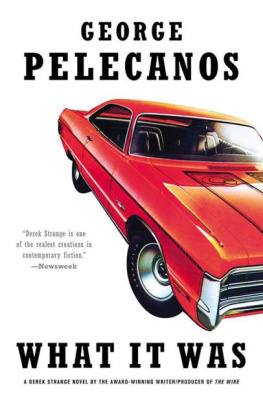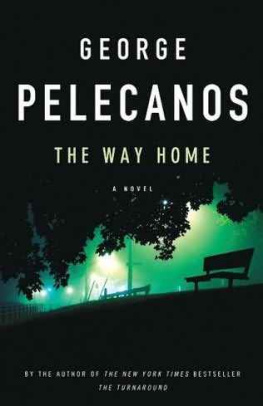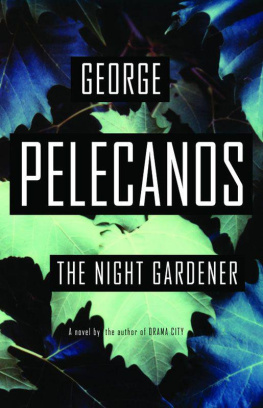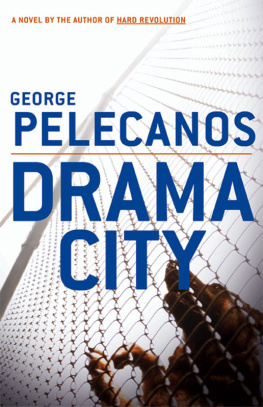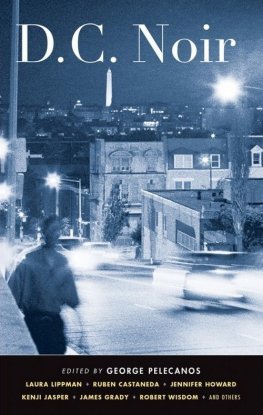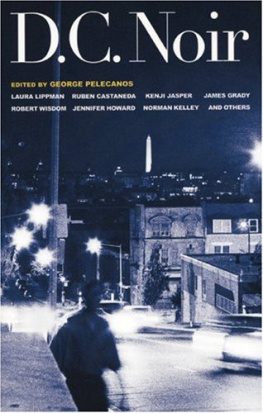George Pelecanos - What It Was
Here you can read online George Pelecanos - What It Was full text of the book (entire story) in english for free. Download pdf and epub, get meaning, cover and reviews about this ebook. year: 2012, publisher: Little, Brown and Company, genre: Detective and thriller. Description of the work, (preface) as well as reviews are available. Best literature library LitArk.com created for fans of good reading and offers a wide selection of genres:
Romance novel
Science fiction
Adventure
Detective
Science
History
Home and family
Prose
Art
Politics
Computer
Non-fiction
Religion
Business
Children
Humor
Choose a favorite category and find really read worthwhile books. Enjoy immersion in the world of imagination, feel the emotions of the characters or learn something new for yourself, make an fascinating discovery.
- Book:What It Was
- Author:
- Publisher:Little, Brown and Company
- Genre:
- Year:2012
- Rating:3 / 5
- Favourites:Add to favourites
- Your mark:
- 60
- 1
- 2
- 3
- 4
- 5
What It Was: summary, description and annotation
We offer to read an annotation, description, summary or preface (depends on what the author of the book "What It Was" wrote himself). If you haven't found the necessary information about the book — write in the comments, we will try to find it.
What It Was — read online for free the complete book (whole text) full work
Below is the text of the book, divided by pages. System saving the place of the last page read, allows you to conveniently read the book "What It Was" online for free, without having to search again every time where you left off. Put a bookmark, and you can go to the page where you finished reading at any time.
Font size:
Interval:
Bookmark:

To Jim Pedas and Ted Pedas
Good Mentors, Good Friends
This novel came about serendipitously, as novels often do. Many years ago I was sitting in the offices of The Wire, bullshitting with my friend and partner, Ed Burns. Before becoming a television writer and producer, Ed, a combat veteran of Vietnam, had been a police officer, a homicide detective, and a public school teacher in Baltimore. Hes lived a full life. Our discussion revolved around his experiences as a young patrolman in uniform, and the relationship between the police and the underworld in the 1970s. Im guessing Ed does not even remember our talk that day, but I do. I was taking notes.
A couple of years later, I was looking through morgue material in the Washington Post, doing some halfhearted research for a possible Watergate novel that I had no great desire to write. In the library I came upon two articles: 5 Held in Plot to Bug Democrats Office Here and Cadillac Smiths Legend of Violence. Both carried the byline of the Posts revered longtime crime reporter Alfred E. Lewis. Sensing something I might use later on, I planted a fable within my novel The Night Gardener (2006) about a character named Red Fury Jones, very loosely based on the exploits of notorious D.C. criminal Raymond Cadillac Smith. It was a way of forcing my hand to eventually complete his story in a future novel. The idea was that someday Id give Red his own book.
As a result of a brief conversation I had with Ed Burns, and two newspaper articles written by Alfred E. Lewis, I had the ammunition to ignite my imagination. What It Was, the book you hold in your hand, was written in a fever in the summer of 2011.
MANY THANKS to Ed Burns and the late Alfred E. Lewis.
. Rocks.
Red or Black? said the bartender. His name was Leonides Vazoulis, but folks on Georgia Avenue called him Leo. The short version was arranged horizontally, in neon, on the sign outside the bar.
Make it the Black.
How about you, patrioti? said Leo, thick and bald, pointing to a fellow Greek who sat beside Strange. Heineken?
The Greek was middle-aged, thin, solidly built, with short hair salted gray. He wore 501s and a faded black T-shirt from the Harley store in Key West. On his feet were black high-top Chucks.
Yeah, said Nick Stefanos. And put a Knob Creek next to it. Neat.
Strange settled in, shifting his broad shoulders beneath his black leather blazer. His closely cropped hair was shaped up and correct. A Vandyke beard, straight silver against dark skin, framed his mouth. Thought you were a Grand-Dad man.
You moved up the shelf. So can I.
I stopped with the Red when I turned sixty. If Im gonna drink, Im gonna enjoy every sip.
Leo served them. They tapped glasses and drank without comment. The silence was pleasant in the way that it can be between men. Plus, Bettye LaVette was singing Your Turn to Cry from the juke. Strange and Stefanos were showing respect.
When the song was done, Stefanos crossed the empty room and stopped at the jukebox, which was stocked with soul rarities, funk, and R&B singles. Strange wondered what Stefanos, a rock and punk man, would choose. Stefanos punched in some buttons and moved toward the head as a song began to play. Through the plate glass fronting Leos, Strange watched a slanting downpour hit the street.
Boy went for theme music, thought Strange. And: Its a good day to drink.
I wanna go outside in the rain, sang Strange, very softly.
It got him to thinking on the year that song had hit the charts. And, as thoughts of the past did more often of late, this drove his mind further into a cinematic recollection of that thrilling time.
Nice choice, said Strange, as Stefanos settled back onto his barstool.
Call it.
The Dramatics. Nineteen seventy-two.
The summer Watergate broke.
You ask some people on this side of town to recollect that year, they wouldnt think on Nixon. Theyre gonna tell you that seventy-two was the summer that Red went off.
Red?
Some called him Red Fury.
Stefanos hit his bourbon and waited for the rest.
Robert Lee Jones was his given name, said Strange. He was known by Red from when he was a kid, on account of his light skin and the tint of his hair. Fury was the car his woman drove.
So?
Youre funny, man.
Strange put up two fingers and made a swirling motion over the empties that were parked on the mahogany. Leo commenced to pouring their next round of drinks.
You were, what, twenty-five in seventy-two?
That summer? I was twenty-six. But this aint about me.
We got all afternoon, said Stefanos.
Then let me tell it, said Strange.
, the GT Sport, a two-door 440 V-8 with hidden headlamps and a four-barrel carb. The color scheme was red over white, and its vanity plates read Coco. White interior made it a womans car. The bright finish and the personalized tags would render the vehicle easily identifiable around town, but Robert Lee Jones was unconcerned. To him it was important that he be remembered and that what he did got done with style.
Jones had bought the Fury for his woman, Coco Watkins, whose Christian name was Shirley. She was in the wheel bucket of the Plymouth, a Viceroy in her long-nailed hand resting atop the drivers-side mirror. She and Jones were idling in park, facing south on 13th, between S and R, in Northwest. The in-dash radio was set on 1450. A Betty Wright number was playing.
Coco, so nicknamed because of the dark, buttery texture of her skin, was tall and strong of thigh. She wore red lipstick and violet eye shadow. When she stood she was finely postured. Her hair was big and it touched the headliner of the car. Jones thought of her as a stallion, if a stallion could be female. Surely they had a name for girl horses, but he couldnt recall it. Aside from prison time, and a West Virginia childhood he barely recalled, he had rarely been outside the city.
Hes in there, said Jones, looking up to the face of the red-brick apartment house on the northeast corner of R. In a second-floor window, against a frayed curtain, was the silhouette of a small man.
How you know its him?
Thats his itty-bitty shadow.
Could be a kid.
He tiny like one. But its him.
Maybe he got a girl up there.
Last time Bobby Odum had a girl, a black man was in the White House.
Wasnt never no black president.
And he aint had no pussy since then.
Cocos shoulders shook as she issued a low laugh. Smoke dribbled through her painted lips.
Leave it run, said Jones.
He got out of the Plymouth and crossed the street in long strides. He, too, was tall. He wore patch-pocket jeans and two-tone brown Flagg Brothers stacks with three-inch heels and curlicue white stitching on the vamps. His loud-print rayon shirt, tails-out, had collars big as spears. His nose had been broken and left unset. He had very light skin, and his face and hard body were prominently freckled and moled. His ratty blowout was the color of rust and its unpicked, misshapen form gave him a general air of I-dont-give-a-fuck. He was as he appeared to be.
Jones entered the building at 13th and R through a glass door set between nonfunctioning gas lanterns. He walked up a flight of stairs and stopped on the second-floor landing, which smelled of cigarettes and marijuana. In the air was the thump of bass coming from the stereo of one of the residents below, and he could feel it pulse through the wood floor. He came to the scarred door that he knew opened to the apartment of Bobby Odum, knocked on the door roughly, after a while heard a muddled voice say, Who it is? and he answered, Red.
Next pageFont size:
Interval:
Bookmark:
Similar books «What It Was»
Look at similar books to What It Was. We have selected literature similar in name and meaning in the hope of providing readers with more options to find new, interesting, not yet read works.
Discussion, reviews of the book What It Was and just readers' own opinions. Leave your comments, write what you think about the work, its meaning or the main characters. Specify what exactly you liked and what you didn't like, and why you think so.

